Epidemiology of Notifiable Diseases, Contact Tracing and Tuberculosis in Australia
VerifiedAdded on 2023/05/31
|13
|3426
|345
AI Summary
This article discusses the epidemiology of notifiable diseases in Australia, contact tracing in epidemiology, and the burden of tuberculosis in Australia. It also covers the transmission of pulmonary TB, high-risk groups for contact tracing, and managing and identifying the contacts.
Contribute Materials
Your contribution can guide someone’s learning journey. Share your
documents today.
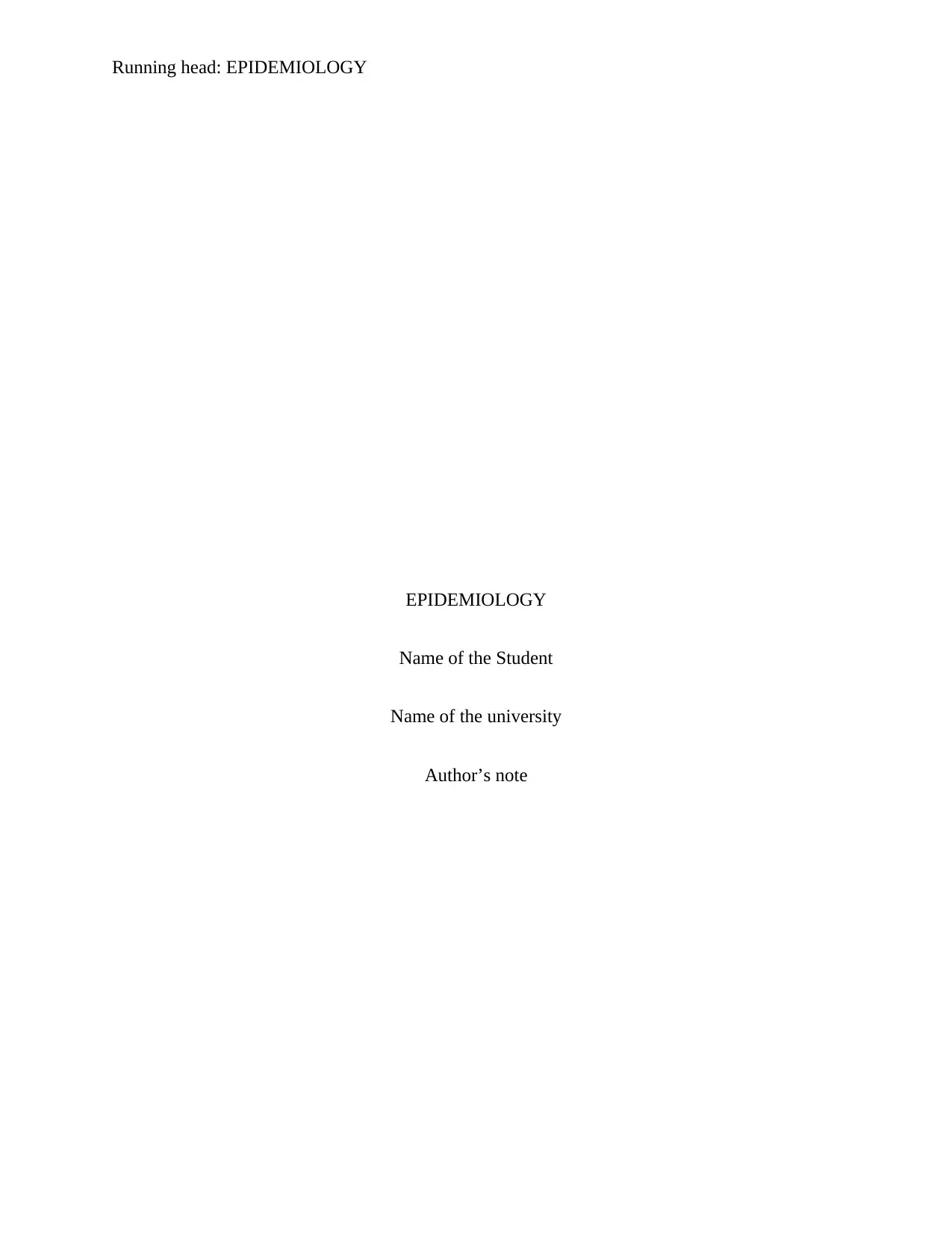
Running head: EPIDEMIOLOGY
EPIDEMIOLOGY
Name of the Student
Name of the university
Author’s note
EPIDEMIOLOGY
Name of the Student
Name of the university
Author’s note
Secure Best Marks with AI Grader
Need help grading? Try our AI Grader for instant feedback on your assignments.
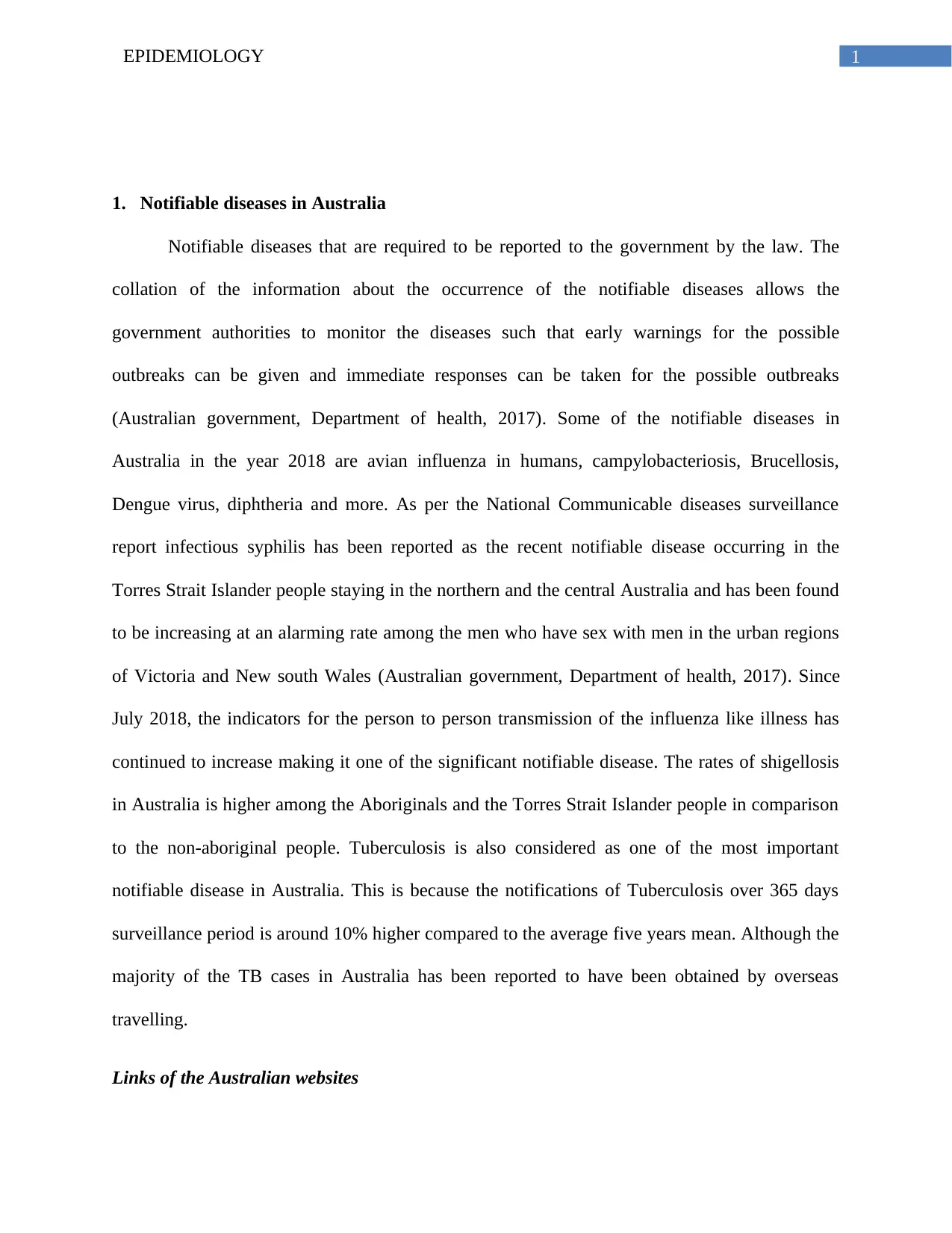
1EPIDEMIOLOGY
1. Notifiable diseases in Australia
Notifiable diseases that are required to be reported to the government by the law. The
collation of the information about the occurrence of the notifiable diseases allows the
government authorities to monitor the diseases such that early warnings for the possible
outbreaks can be given and immediate responses can be taken for the possible outbreaks
(Australian government, Department of health, 2017). Some of the notifiable diseases in
Australia in the year 2018 are avian influenza in humans, campylobacteriosis, Brucellosis,
Dengue virus, diphtheria and more. As per the National Communicable diseases surveillance
report infectious syphilis has been reported as the recent notifiable disease occurring in the
Torres Strait Islander people staying in the northern and the central Australia and has been found
to be increasing at an alarming rate among the men who have sex with men in the urban regions
of Victoria and New south Wales (Australian government, Department of health, 2017). Since
July 2018, the indicators for the person to person transmission of the influenza like illness has
continued to increase making it one of the significant notifiable disease. The rates of shigellosis
in Australia is higher among the Aboriginals and the Torres Strait Islander people in comparison
to the non-aboriginal people. Tuberculosis is also considered as one of the most important
notifiable disease in Australia. This is because the notifications of Tuberculosis over 365 days
surveillance period is around 10% higher compared to the average five years mean. Although the
majority of the TB cases in Australia has been reported to have been obtained by overseas
travelling.
Links of the Australian websites
1. Notifiable diseases in Australia
Notifiable diseases that are required to be reported to the government by the law. The
collation of the information about the occurrence of the notifiable diseases allows the
government authorities to monitor the diseases such that early warnings for the possible
outbreaks can be given and immediate responses can be taken for the possible outbreaks
(Australian government, Department of health, 2017). Some of the notifiable diseases in
Australia in the year 2018 are avian influenza in humans, campylobacteriosis, Brucellosis,
Dengue virus, diphtheria and more. As per the National Communicable diseases surveillance
report infectious syphilis has been reported as the recent notifiable disease occurring in the
Torres Strait Islander people staying in the northern and the central Australia and has been found
to be increasing at an alarming rate among the men who have sex with men in the urban regions
of Victoria and New south Wales (Australian government, Department of health, 2017). Since
July 2018, the indicators for the person to person transmission of the influenza like illness has
continued to increase making it one of the significant notifiable disease. The rates of shigellosis
in Australia is higher among the Aboriginals and the Torres Strait Islander people in comparison
to the non-aboriginal people. Tuberculosis is also considered as one of the most important
notifiable disease in Australia. This is because the notifications of Tuberculosis over 365 days
surveillance period is around 10% higher compared to the average five years mean. Although the
majority of the TB cases in Australia has been reported to have been obtained by overseas
travelling.
Links of the Australian websites
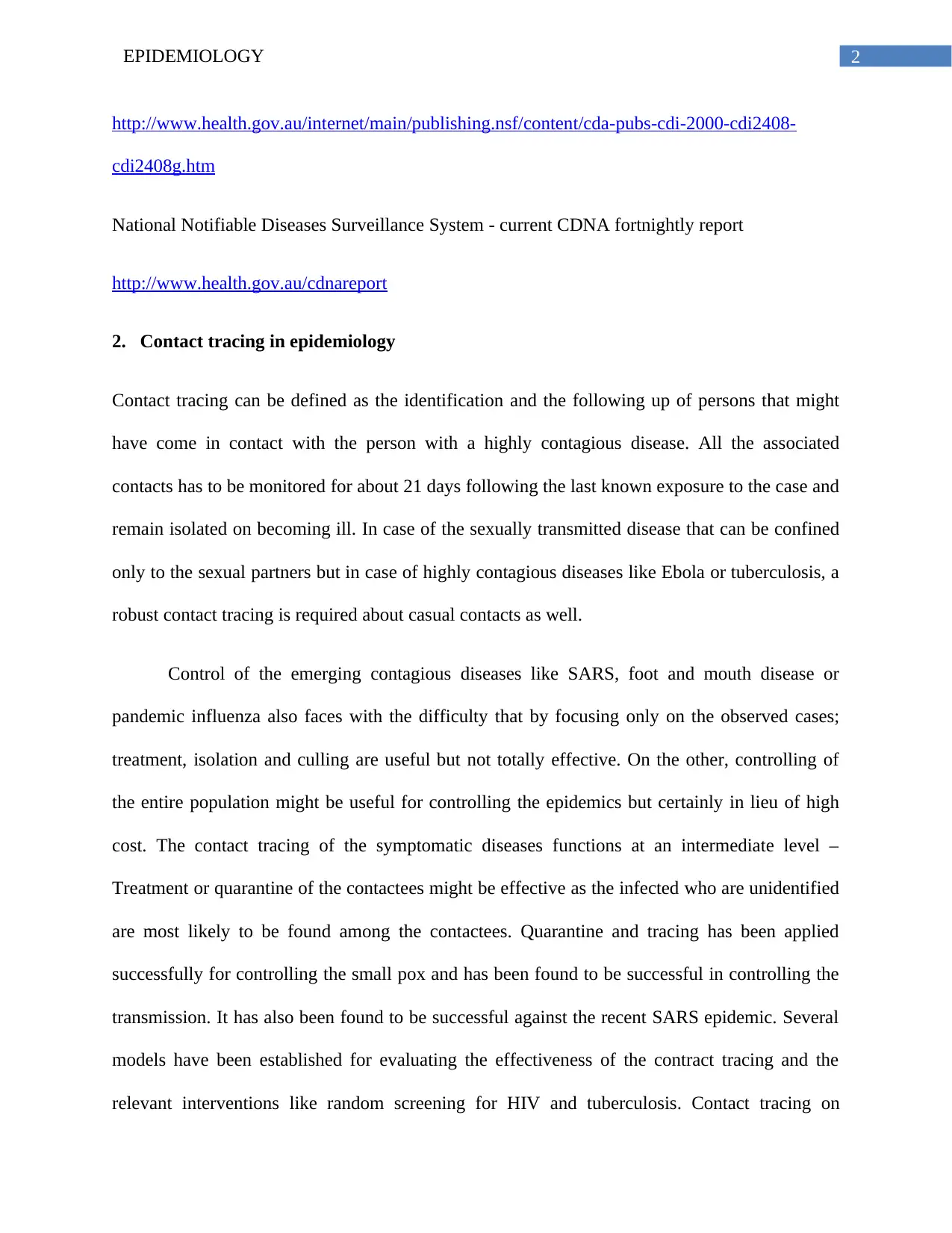
2EPIDEMIOLOGY
http://www.health.gov.au/internet/main/publishing.nsf/content/cda-pubs-cdi-2000-cdi2408-
cdi2408g.htm
National Notifiable Diseases Surveillance System - current CDNA fortnightly report
http://www.health.gov.au/cdnareport
2. Contact tracing in epidemiology
Contact tracing can be defined as the identification and the following up of persons that might
have come in contact with the person with a highly contagious disease. All the associated
contacts has to be monitored for about 21 days following the last known exposure to the case and
remain isolated on becoming ill. In case of the sexually transmitted disease that can be confined
only to the sexual partners but in case of highly contagious diseases like Ebola or tuberculosis, a
robust contact tracing is required about casual contacts as well.
Control of the emerging contagious diseases like SARS, foot and mouth disease or
pandemic influenza also faces with the difficulty that by focusing only on the observed cases;
treatment, isolation and culling are useful but not totally effective. On the other, controlling of
the entire population might be useful for controlling the epidemics but certainly in lieu of high
cost. The contact tracing of the symptomatic diseases functions at an intermediate level –
Treatment or quarantine of the contactees might be effective as the infected who are unidentified
are most likely to be found among the contactees. Quarantine and tracing has been applied
successfully for controlling the small pox and has been found to be successful in controlling the
transmission. It has also been found to be successful against the recent SARS epidemic. Several
models have been established for evaluating the effectiveness of the contract tracing and the
relevant interventions like random screening for HIV and tuberculosis. Contact tracing on
http://www.health.gov.au/internet/main/publishing.nsf/content/cda-pubs-cdi-2000-cdi2408-
cdi2408g.htm
National Notifiable Diseases Surveillance System - current CDNA fortnightly report
http://www.health.gov.au/cdnareport
2. Contact tracing in epidemiology
Contact tracing can be defined as the identification and the following up of persons that might
have come in contact with the person with a highly contagious disease. All the associated
contacts has to be monitored for about 21 days following the last known exposure to the case and
remain isolated on becoming ill. In case of the sexually transmitted disease that can be confined
only to the sexual partners but in case of highly contagious diseases like Ebola or tuberculosis, a
robust contact tracing is required about casual contacts as well.
Control of the emerging contagious diseases like SARS, foot and mouth disease or
pandemic influenza also faces with the difficulty that by focusing only on the observed cases;
treatment, isolation and culling are useful but not totally effective. On the other, controlling of
the entire population might be useful for controlling the epidemics but certainly in lieu of high
cost. The contact tracing of the symptomatic diseases functions at an intermediate level –
Treatment or quarantine of the contactees might be effective as the infected who are unidentified
are most likely to be found among the contactees. Quarantine and tracing has been applied
successfully for controlling the small pox and has been found to be successful in controlling the
transmission. It has also been found to be successful against the recent SARS epidemic. Several
models have been established for evaluating the effectiveness of the contract tracing and the
relevant interventions like random screening for HIV and tuberculosis. Contact tracing on
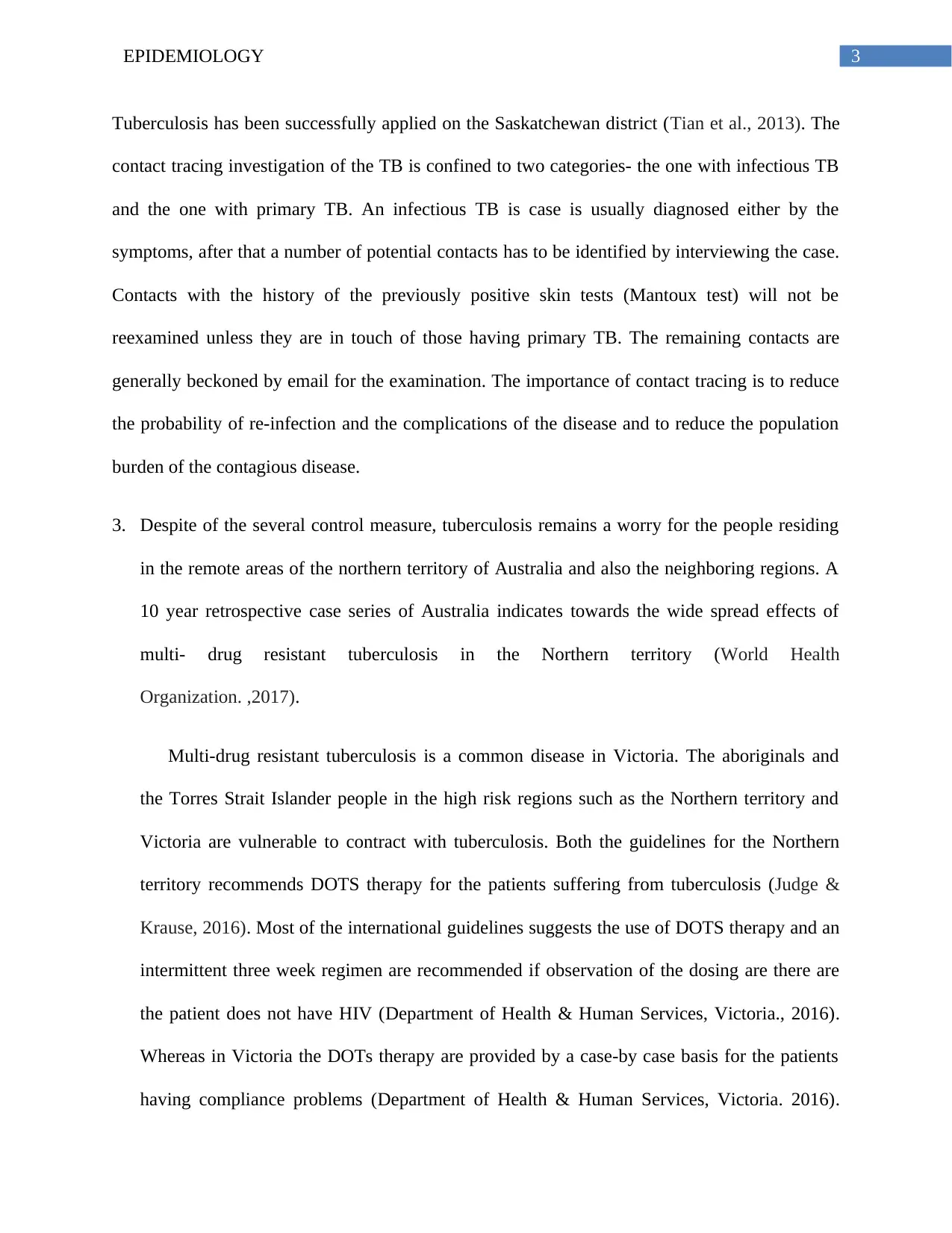
3EPIDEMIOLOGY
Tuberculosis has been successfully applied on the Saskatchewan district (Tian et al., 2013). The
contact tracing investigation of the TB is confined to two categories- the one with infectious TB
and the one with primary TB. An infectious TB is case is usually diagnosed either by the
symptoms, after that a number of potential contacts has to be identified by interviewing the case.
Contacts with the history of the previously positive skin tests (Mantoux test) will not be
reexamined unless they are in touch of those having primary TB. The remaining contacts are
generally beckoned by email for the examination. The importance of contact tracing is to reduce
the probability of re-infection and the complications of the disease and to reduce the population
burden of the contagious disease.
3. Despite of the several control measure, tuberculosis remains a worry for the people residing
in the remote areas of the northern territory of Australia and also the neighboring regions. A
10 year retrospective case series of Australia indicates towards the wide spread effects of
multi- drug resistant tuberculosis in the Northern territory (World Health
Organization. ,2017).
Multi-drug resistant tuberculosis is a common disease in Victoria. The aboriginals and
the Torres Strait Islander people in the high risk regions such as the Northern territory and
Victoria are vulnerable to contract with tuberculosis. Both the guidelines for the Northern
territory recommends DOTS therapy for the patients suffering from tuberculosis (Judge &
Krause, 2016). Most of the international guidelines suggests the use of DOTS therapy and an
intermittent three week regimen are recommended if observation of the dosing are there are
the patient does not have HIV (Department of Health & Human Services, Victoria., 2016).
Whereas in Victoria the DOTs therapy are provided by a case-by case basis for the patients
having compliance problems (Department of Health & Human Services, Victoria. 2016).
Tuberculosis has been successfully applied on the Saskatchewan district (Tian et al., 2013). The
contact tracing investigation of the TB is confined to two categories- the one with infectious TB
and the one with primary TB. An infectious TB is case is usually diagnosed either by the
symptoms, after that a number of potential contacts has to be identified by interviewing the case.
Contacts with the history of the previously positive skin tests (Mantoux test) will not be
reexamined unless they are in touch of those having primary TB. The remaining contacts are
generally beckoned by email for the examination. The importance of contact tracing is to reduce
the probability of re-infection and the complications of the disease and to reduce the population
burden of the contagious disease.
3. Despite of the several control measure, tuberculosis remains a worry for the people residing
in the remote areas of the northern territory of Australia and also the neighboring regions. A
10 year retrospective case series of Australia indicates towards the wide spread effects of
multi- drug resistant tuberculosis in the Northern territory (World Health
Organization. ,2017).
Multi-drug resistant tuberculosis is a common disease in Victoria. The aboriginals and
the Torres Strait Islander people in the high risk regions such as the Northern territory and
Victoria are vulnerable to contract with tuberculosis. Both the guidelines for the Northern
territory recommends DOTS therapy for the patients suffering from tuberculosis (Judge &
Krause, 2016). Most of the international guidelines suggests the use of DOTS therapy and an
intermittent three week regimen are recommended if observation of the dosing are there are
the patient does not have HIV (Department of Health & Human Services, Victoria., 2016).
Whereas in Victoria the DOTs therapy are provided by a case-by case basis for the patients
having compliance problems (Department of Health & Human Services, Victoria. 2016).
Secure Best Marks with AI Grader
Need help grading? Try our AI Grader for instant feedback on your assignments.
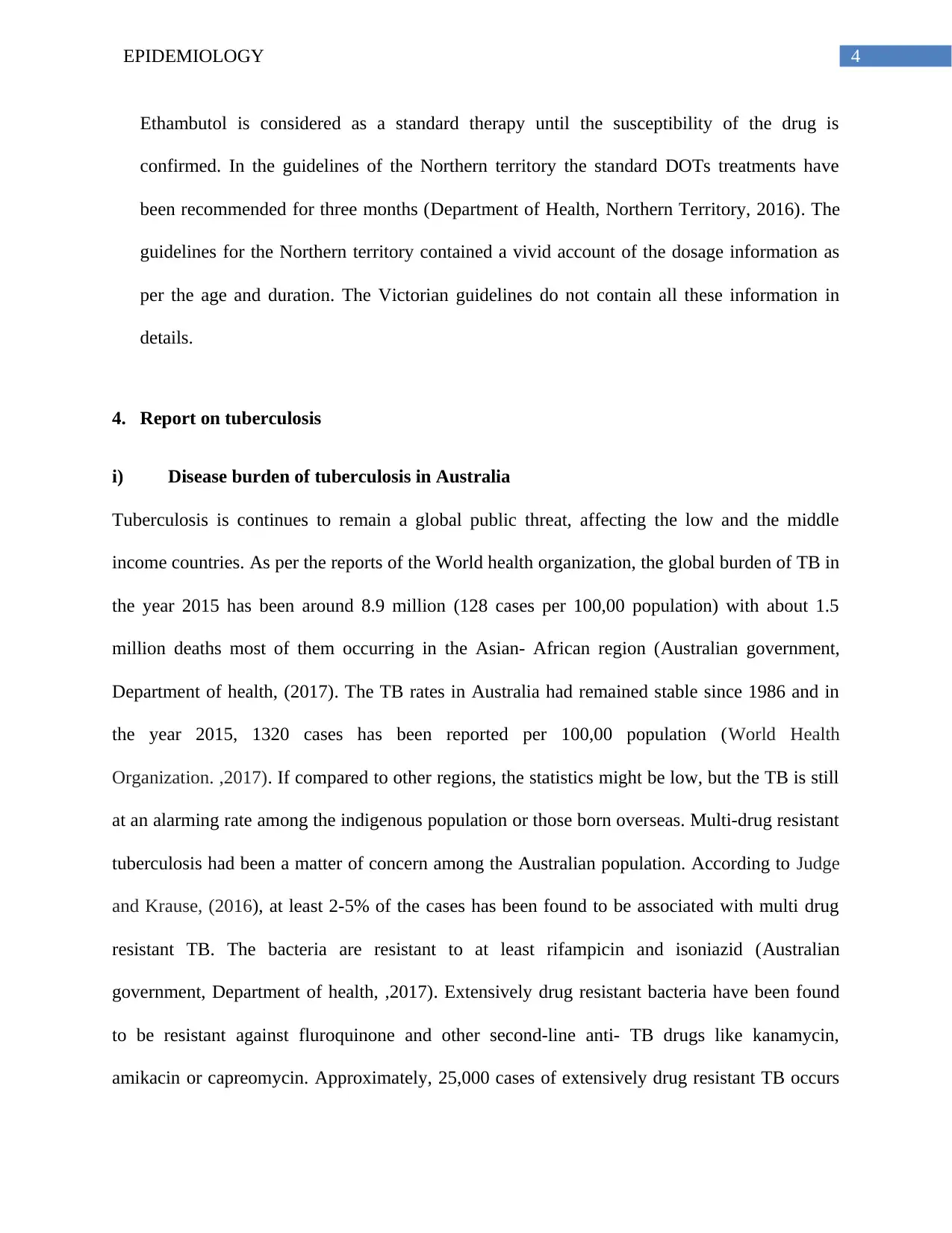
4EPIDEMIOLOGY
Ethambutol is considered as a standard therapy until the susceptibility of the drug is
confirmed. In the guidelines of the Northern territory the standard DOTs treatments have
been recommended for three months (Department of Health, Northern Territory, 2016). The
guidelines for the Northern territory contained a vivid account of the dosage information as
per the age and duration. The Victorian guidelines do not contain all these information in
details.
4. Report on tuberculosis
i) Disease burden of tuberculosis in Australia
Tuberculosis is continues to remain a global public threat, affecting the low and the middle
income countries. As per the reports of the World health organization, the global burden of TB in
the year 2015 has been around 8.9 million (128 cases per 100,00 population) with about 1.5
million deaths most of them occurring in the Asian- African region (Australian government,
Department of health, (2017). The TB rates in Australia had remained stable since 1986 and in
the year 2015, 1320 cases has been reported per 100,00 population (World Health
Organization. ,2017). If compared to other regions, the statistics might be low, but the TB is still
at an alarming rate among the indigenous population or those born overseas. Multi-drug resistant
tuberculosis had been a matter of concern among the Australian population. According to Judge
and Krause, (2016), at least 2-5% of the cases has been found to be associated with multi drug
resistant TB. The bacteria are resistant to at least rifampicin and isoniazid (Australian
government, Department of health, ,2017). Extensively drug resistant bacteria have been found
to be resistant against fluroquinone and other second-line anti- TB drugs like kanamycin,
amikacin or capreomycin. Approximately, 25,000 cases of extensively drug resistant TB occurs
Ethambutol is considered as a standard therapy until the susceptibility of the drug is
confirmed. In the guidelines of the Northern territory the standard DOTs treatments have
been recommended for three months (Department of Health, Northern Territory, 2016). The
guidelines for the Northern territory contained a vivid account of the dosage information as
per the age and duration. The Victorian guidelines do not contain all these information in
details.
4. Report on tuberculosis
i) Disease burden of tuberculosis in Australia
Tuberculosis is continues to remain a global public threat, affecting the low and the middle
income countries. As per the reports of the World health organization, the global burden of TB in
the year 2015 has been around 8.9 million (128 cases per 100,00 population) with about 1.5
million deaths most of them occurring in the Asian- African region (Australian government,
Department of health, (2017). The TB rates in Australia had remained stable since 1986 and in
the year 2015, 1320 cases has been reported per 100,00 population (World Health
Organization. ,2017). If compared to other regions, the statistics might be low, but the TB is still
at an alarming rate among the indigenous population or those born overseas. Multi-drug resistant
tuberculosis had been a matter of concern among the Australian population. According to Judge
and Krause, (2016), at least 2-5% of the cases has been found to be associated with multi drug
resistant TB. The bacteria are resistant to at least rifampicin and isoniazid (Australian
government, Department of health, ,2017). Extensively drug resistant bacteria have been found
to be resistant against fluroquinone and other second-line anti- TB drugs like kanamycin,
amikacin or capreomycin. Approximately, 25,000 cases of extensively drug resistant TB occurs
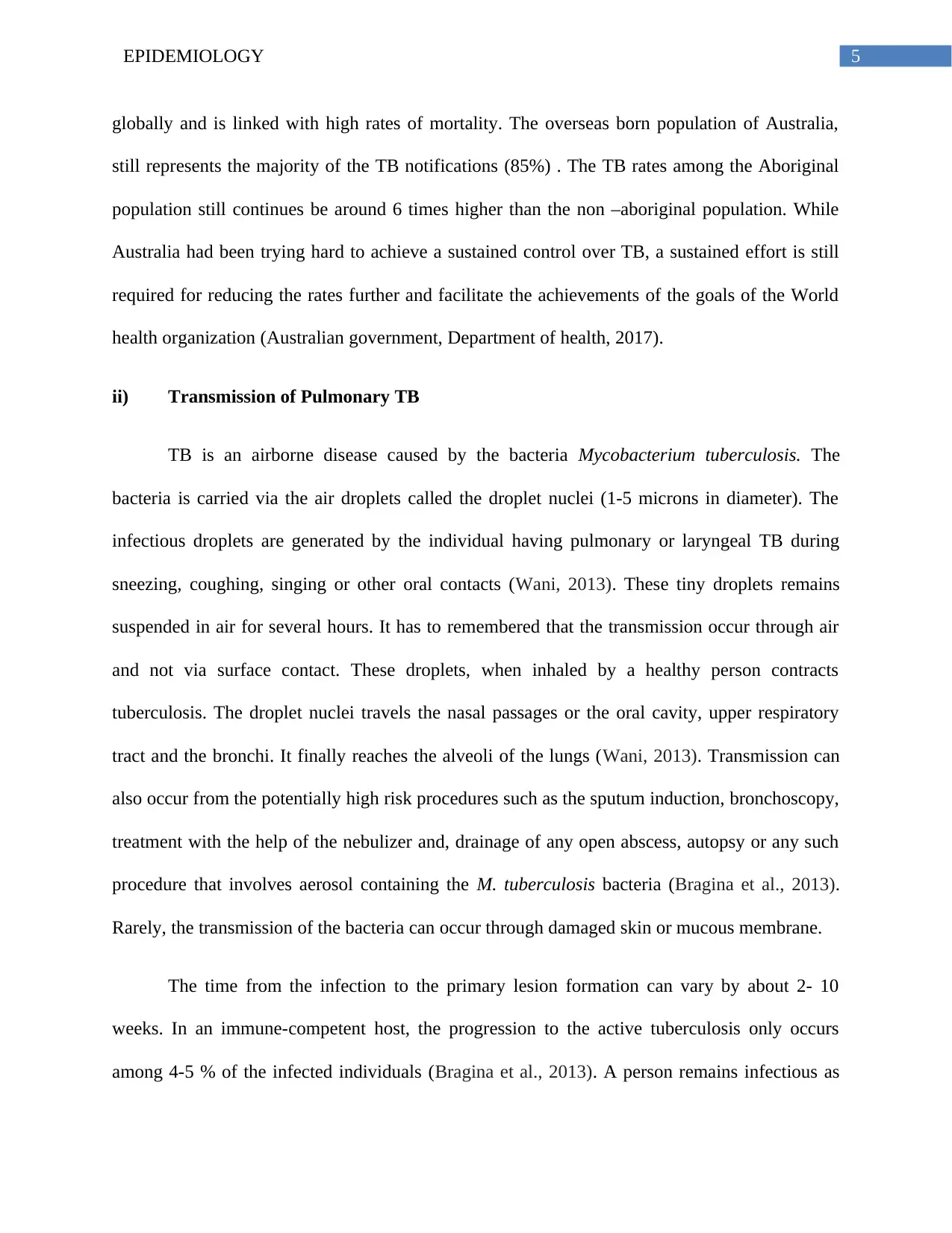
5EPIDEMIOLOGY
globally and is linked with high rates of mortality. The overseas born population of Australia,
still represents the majority of the TB notifications (85%) . The TB rates among the Aboriginal
population still continues be around 6 times higher than the non –aboriginal population. While
Australia had been trying hard to achieve a sustained control over TB, a sustained effort is still
required for reducing the rates further and facilitate the achievements of the goals of the World
health organization (Australian government, Department of health, 2017).
ii) Transmission of Pulmonary TB
TB is an airborne disease caused by the bacteria Mycobacterium tuberculosis. The
bacteria is carried via the air droplets called the droplet nuclei (1-5 microns in diameter). The
infectious droplets are generated by the individual having pulmonary or laryngeal TB during
sneezing, coughing, singing or other oral contacts (Wani, 2013). These tiny droplets remains
suspended in air for several hours. It has to remembered that the transmission occur through air
and not via surface contact. These droplets, when inhaled by a healthy person contracts
tuberculosis. The droplet nuclei travels the nasal passages or the oral cavity, upper respiratory
tract and the bronchi. It finally reaches the alveoli of the lungs (Wani, 2013). Transmission can
also occur from the potentially high risk procedures such as the sputum induction, bronchoscopy,
treatment with the help of the nebulizer and, drainage of any open abscess, autopsy or any such
procedure that involves aerosol containing the M. tuberculosis bacteria (Bragina et al., 2013).
Rarely, the transmission of the bacteria can occur through damaged skin or mucous membrane.
The time from the infection to the primary lesion formation can vary by about 2- 10
weeks. In an immune-competent host, the progression to the active tuberculosis only occurs
among 4-5 % of the infected individuals (Bragina et al., 2013). A person remains infectious as
globally and is linked with high rates of mortality. The overseas born population of Australia,
still represents the majority of the TB notifications (85%) . The TB rates among the Aboriginal
population still continues be around 6 times higher than the non –aboriginal population. While
Australia had been trying hard to achieve a sustained control over TB, a sustained effort is still
required for reducing the rates further and facilitate the achievements of the goals of the World
health organization (Australian government, Department of health, 2017).
ii) Transmission of Pulmonary TB
TB is an airborne disease caused by the bacteria Mycobacterium tuberculosis. The
bacteria is carried via the air droplets called the droplet nuclei (1-5 microns in diameter). The
infectious droplets are generated by the individual having pulmonary or laryngeal TB during
sneezing, coughing, singing or other oral contacts (Wani, 2013). These tiny droplets remains
suspended in air for several hours. It has to remembered that the transmission occur through air
and not via surface contact. These droplets, when inhaled by a healthy person contracts
tuberculosis. The droplet nuclei travels the nasal passages or the oral cavity, upper respiratory
tract and the bronchi. It finally reaches the alveoli of the lungs (Wani, 2013). Transmission can
also occur from the potentially high risk procedures such as the sputum induction, bronchoscopy,
treatment with the help of the nebulizer and, drainage of any open abscess, autopsy or any such
procedure that involves aerosol containing the M. tuberculosis bacteria (Bragina et al., 2013).
Rarely, the transmission of the bacteria can occur through damaged skin or mucous membrane.
The time from the infection to the primary lesion formation can vary by about 2- 10
weeks. In an immune-competent host, the progression to the active tuberculosis only occurs
among 4-5 % of the infected individuals (Bragina et al., 2013). A person remains infectious as
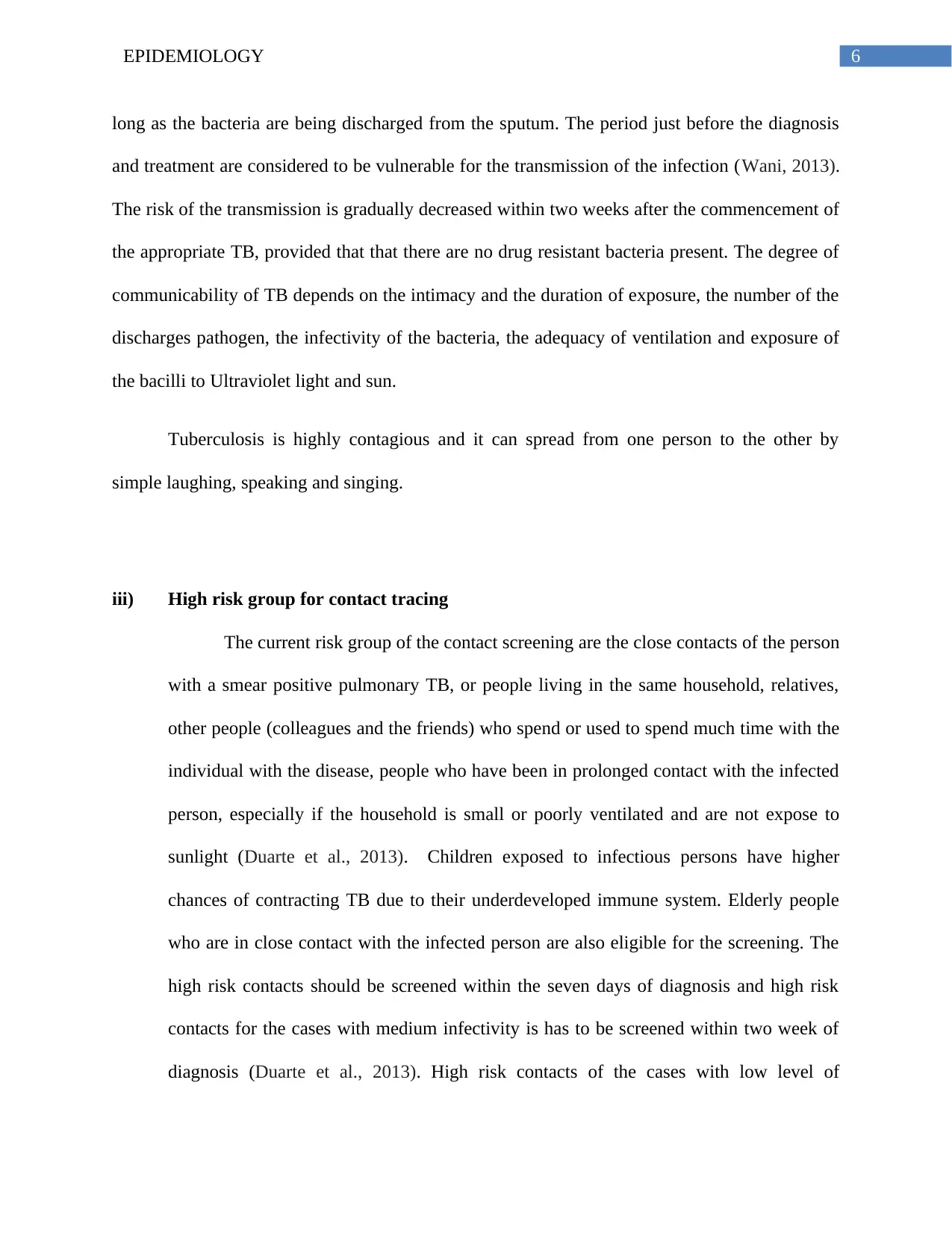
6EPIDEMIOLOGY
long as the bacteria are being discharged from the sputum. The period just before the diagnosis
and treatment are considered to be vulnerable for the transmission of the infection (Wani, 2013).
The risk of the transmission is gradually decreased within two weeks after the commencement of
the appropriate TB, provided that that there are no drug resistant bacteria present. The degree of
communicability of TB depends on the intimacy and the duration of exposure, the number of the
discharges pathogen, the infectivity of the bacteria, the adequacy of ventilation and exposure of
the bacilli to Ultraviolet light and sun.
Tuberculosis is highly contagious and it can spread from one person to the other by
simple laughing, speaking and singing.
iii) High risk group for contact tracing
The current risk group of the contact screening are the close contacts of the person
with a smear positive pulmonary TB, or people living in the same household, relatives,
other people (colleagues and the friends) who spend or used to spend much time with the
individual with the disease, people who have been in prolonged contact with the infected
person, especially if the household is small or poorly ventilated and are not expose to
sunlight (Duarte et al., 2013). Children exposed to infectious persons have higher
chances of contracting TB due to their underdeveloped immune system. Elderly people
who are in close contact with the infected person are also eligible for the screening. The
high risk contacts should be screened within the seven days of diagnosis and high risk
contacts for the cases with medium infectivity is has to be screened within two week of
diagnosis (Duarte et al., 2013). High risk contacts of the cases with low level of
long as the bacteria are being discharged from the sputum. The period just before the diagnosis
and treatment are considered to be vulnerable for the transmission of the infection (Wani, 2013).
The risk of the transmission is gradually decreased within two weeks after the commencement of
the appropriate TB, provided that that there are no drug resistant bacteria present. The degree of
communicability of TB depends on the intimacy and the duration of exposure, the number of the
discharges pathogen, the infectivity of the bacteria, the adequacy of ventilation and exposure of
the bacilli to Ultraviolet light and sun.
Tuberculosis is highly contagious and it can spread from one person to the other by
simple laughing, speaking and singing.
iii) High risk group for contact tracing
The current risk group of the contact screening are the close contacts of the person
with a smear positive pulmonary TB, or people living in the same household, relatives,
other people (colleagues and the friends) who spend or used to spend much time with the
individual with the disease, people who have been in prolonged contact with the infected
person, especially if the household is small or poorly ventilated and are not expose to
sunlight (Duarte et al., 2013). Children exposed to infectious persons have higher
chances of contracting TB due to their underdeveloped immune system. Elderly people
who are in close contact with the infected person are also eligible for the screening. The
high risk contacts should be screened within the seven days of diagnosis and high risk
contacts for the cases with medium infectivity is has to be screened within two week of
diagnosis (Duarte et al., 2013). High risk contacts of the cases with low level of
Paraphrase This Document
Need a fresh take? Get an instant paraphrase of this document with our AI Paraphraser
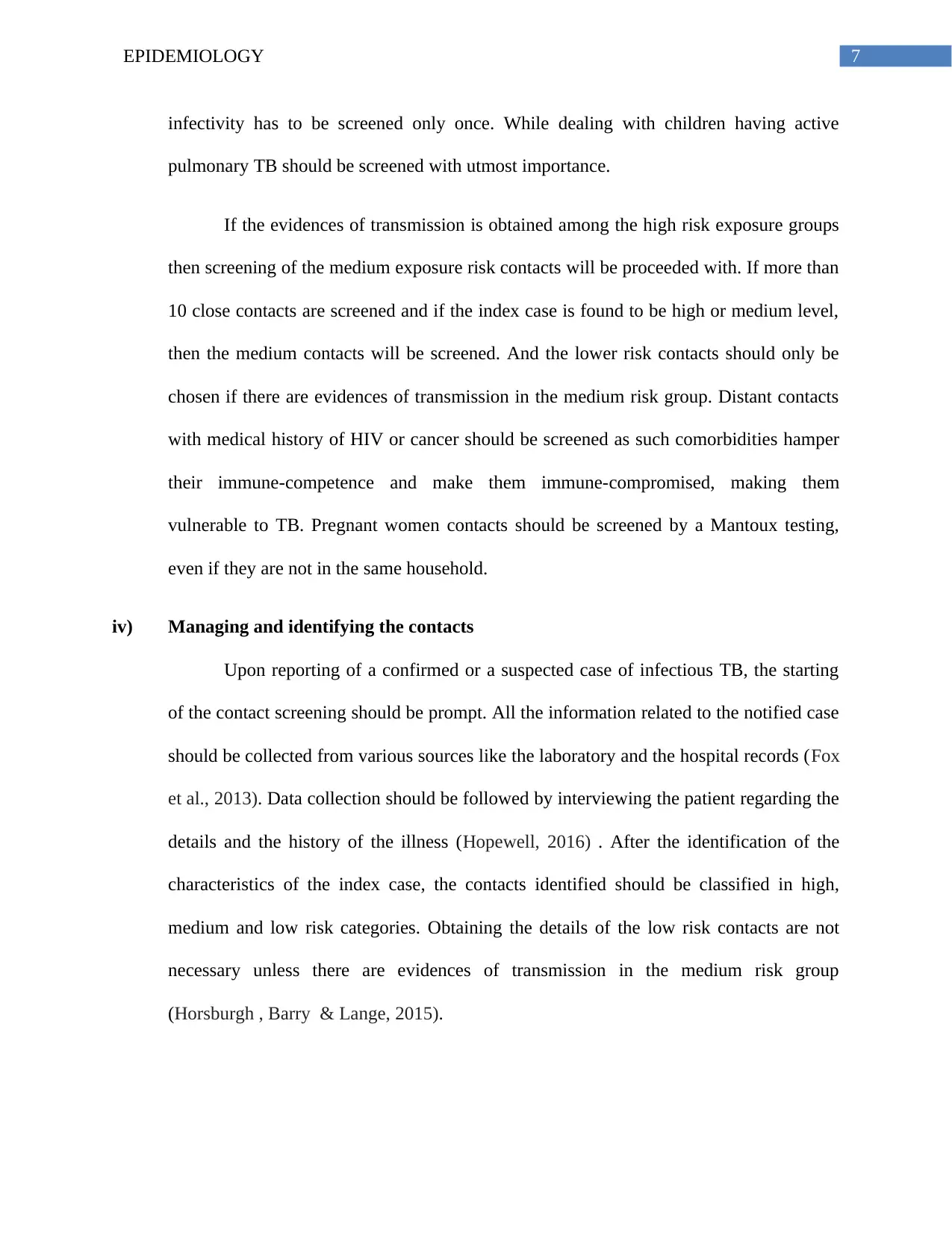
7EPIDEMIOLOGY
infectivity has to be screened only once. While dealing with children having active
pulmonary TB should be screened with utmost importance.
If the evidences of transmission is obtained among the high risk exposure groups
then screening of the medium exposure risk contacts will be proceeded with. If more than
10 close contacts are screened and if the index case is found to be high or medium level,
then the medium contacts will be screened. And the lower risk contacts should only be
chosen if there are evidences of transmission in the medium risk group. Distant contacts
with medical history of HIV or cancer should be screened as such comorbidities hamper
their immune-competence and make them immune-compromised, making them
vulnerable to TB. Pregnant women contacts should be screened by a Mantoux testing,
even if they are not in the same household.
iv) Managing and identifying the contacts
Upon reporting of a confirmed or a suspected case of infectious TB, the starting
of the contact screening should be prompt. All the information related to the notified case
should be collected from various sources like the laboratory and the hospital records (Fox
et al., 2013). Data collection should be followed by interviewing the patient regarding the
details and the history of the illness (Hopewell, 2016) . After the identification of the
characteristics of the index case, the contacts identified should be classified in high,
medium and low risk categories. Obtaining the details of the low risk contacts are not
necessary unless there are evidences of transmission in the medium risk group
(Horsburgh , Barry & Lange, 2015).
infectivity has to be screened only once. While dealing with children having active
pulmonary TB should be screened with utmost importance.
If the evidences of transmission is obtained among the high risk exposure groups
then screening of the medium exposure risk contacts will be proceeded with. If more than
10 close contacts are screened and if the index case is found to be high or medium level,
then the medium contacts will be screened. And the lower risk contacts should only be
chosen if there are evidences of transmission in the medium risk group. Distant contacts
with medical history of HIV or cancer should be screened as such comorbidities hamper
their immune-competence and make them immune-compromised, making them
vulnerable to TB. Pregnant women contacts should be screened by a Mantoux testing,
even if they are not in the same household.
iv) Managing and identifying the contacts
Upon reporting of a confirmed or a suspected case of infectious TB, the starting
of the contact screening should be prompt. All the information related to the notified case
should be collected from various sources like the laboratory and the hospital records (Fox
et al., 2013). Data collection should be followed by interviewing the patient regarding the
details and the history of the illness (Hopewell, 2016) . After the identification of the
characteristics of the index case, the contacts identified should be classified in high,
medium and low risk categories. Obtaining the details of the low risk contacts are not
necessary unless there are evidences of transmission in the medium risk group
(Horsburgh , Barry & Lange, 2015).
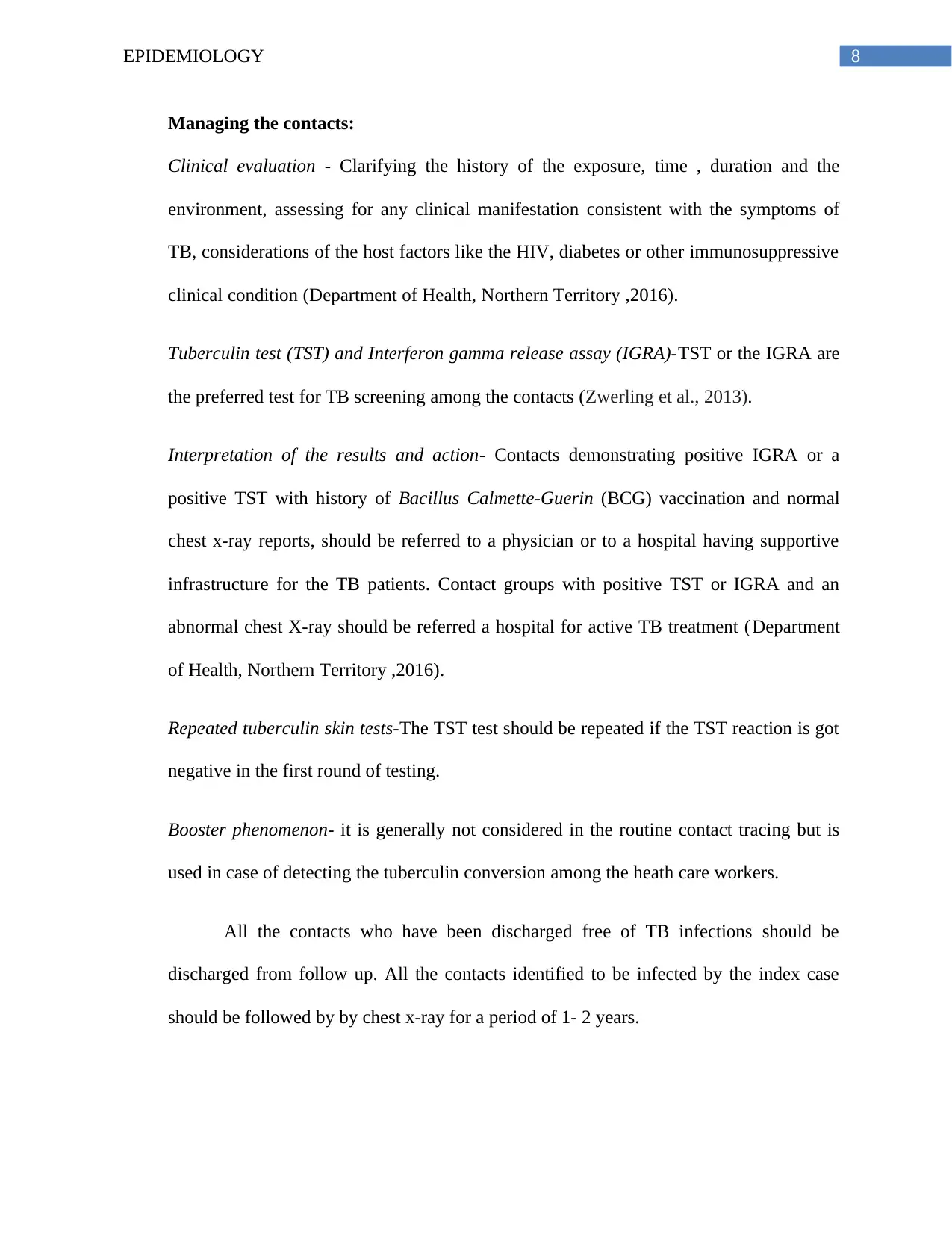
8EPIDEMIOLOGY
Managing the contacts:
Clinical evaluation - Clarifying the history of the exposure, time , duration and the
environment, assessing for any clinical manifestation consistent with the symptoms of
TB, considerations of the host factors like the HIV, diabetes or other immunosuppressive
clinical condition (Department of Health, Northern Territory ,2016).
Tuberculin test (TST) and Interferon gamma release assay (IGRA)-TST or the IGRA are
the preferred test for TB screening among the contacts (Zwerling et al., 2013).
Interpretation of the results and action- Contacts demonstrating positive IGRA or a
positive TST with history of Bacillus Calmette-Guerin (BCG) vaccination and normal
chest x-ray reports, should be referred to a physician or to a hospital having supportive
infrastructure for the TB patients. Contact groups with positive TST or IGRA and an
abnormal chest X-ray should be referred a hospital for active TB treatment (Department
of Health, Northern Territory ,2016).
Repeated tuberculin skin tests-The TST test should be repeated if the TST reaction is got
negative in the first round of testing.
Booster phenomenon- it is generally not considered in the routine contact tracing but is
used in case of detecting the tuberculin conversion among the heath care workers.
All the contacts who have been discharged free of TB infections should be
discharged from follow up. All the contacts identified to be infected by the index case
should be followed by by chest x-ray for a period of 1- 2 years.
Managing the contacts:
Clinical evaluation - Clarifying the history of the exposure, time , duration and the
environment, assessing for any clinical manifestation consistent with the symptoms of
TB, considerations of the host factors like the HIV, diabetes or other immunosuppressive
clinical condition (Department of Health, Northern Territory ,2016).
Tuberculin test (TST) and Interferon gamma release assay (IGRA)-TST or the IGRA are
the preferred test for TB screening among the contacts (Zwerling et al., 2013).
Interpretation of the results and action- Contacts demonstrating positive IGRA or a
positive TST with history of Bacillus Calmette-Guerin (BCG) vaccination and normal
chest x-ray reports, should be referred to a physician or to a hospital having supportive
infrastructure for the TB patients. Contact groups with positive TST or IGRA and an
abnormal chest X-ray should be referred a hospital for active TB treatment (Department
of Health, Northern Territory ,2016).
Repeated tuberculin skin tests-The TST test should be repeated if the TST reaction is got
negative in the first round of testing.
Booster phenomenon- it is generally not considered in the routine contact tracing but is
used in case of detecting the tuberculin conversion among the heath care workers.
All the contacts who have been discharged free of TB infections should be
discharged from follow up. All the contacts identified to be infected by the index case
should be followed by by chest x-ray for a period of 1- 2 years.
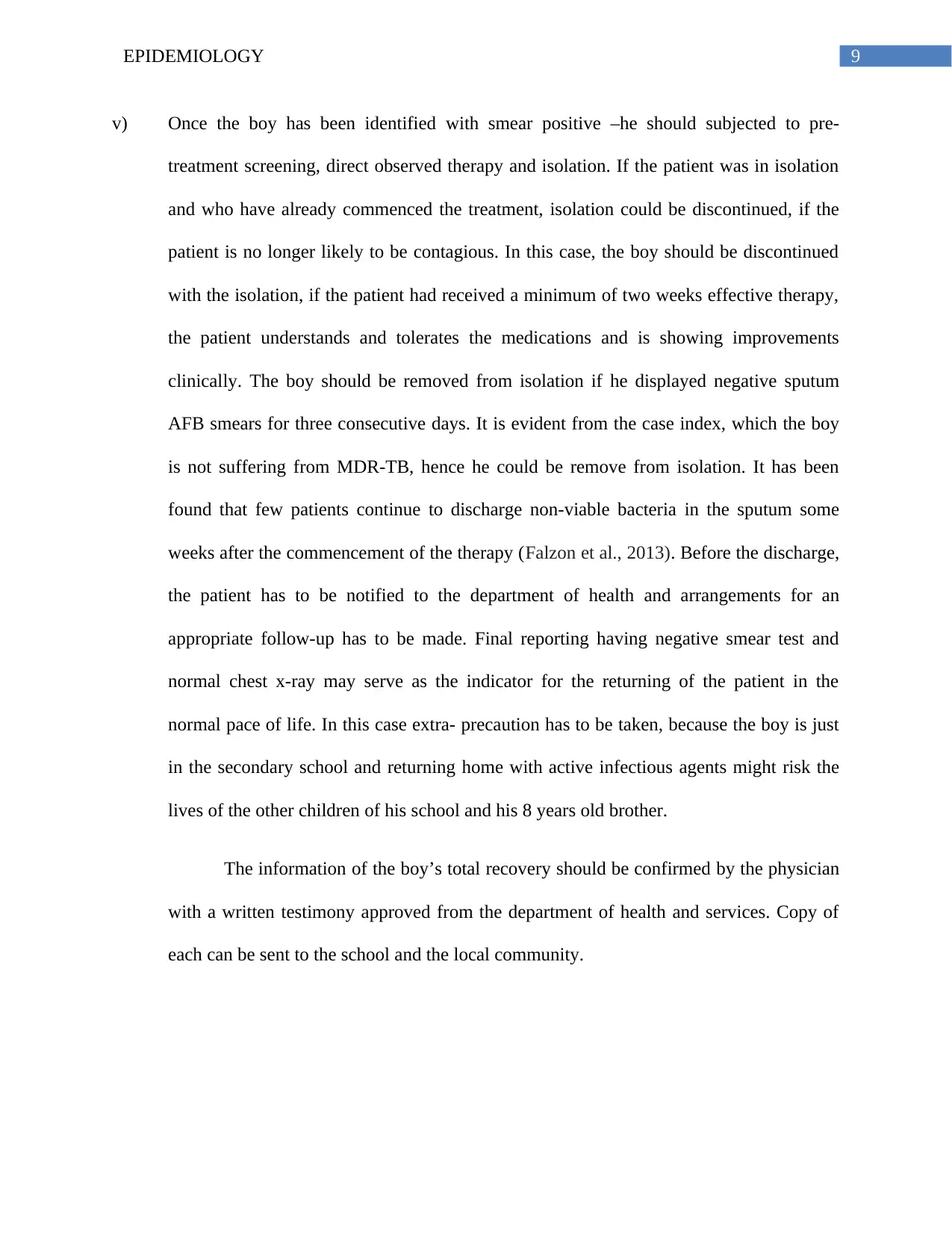
9EPIDEMIOLOGY
v) Once the boy has been identified with smear positive –he should subjected to pre-
treatment screening, direct observed therapy and isolation. If the patient was in isolation
and who have already commenced the treatment, isolation could be discontinued, if the
patient is no longer likely to be contagious. In this case, the boy should be discontinued
with the isolation, if the patient had received a minimum of two weeks effective therapy,
the patient understands and tolerates the medications and is showing improvements
clinically. The boy should be removed from isolation if he displayed negative sputum
AFB smears for three consecutive days. It is evident from the case index, which the boy
is not suffering from MDR-TB, hence he could be remove from isolation. It has been
found that few patients continue to discharge non-viable bacteria in the sputum some
weeks after the commencement of the therapy (Falzon et al., 2013). Before the discharge,
the patient has to be notified to the department of health and arrangements for an
appropriate follow-up has to be made. Final reporting having negative smear test and
normal chest x-ray may serve as the indicator for the returning of the patient in the
normal pace of life. In this case extra- precaution has to be taken, because the boy is just
in the secondary school and returning home with active infectious agents might risk the
lives of the other children of his school and his 8 years old brother.
The information of the boy’s total recovery should be confirmed by the physician
with a written testimony approved from the department of health and services. Copy of
each can be sent to the school and the local community.
v) Once the boy has been identified with smear positive –he should subjected to pre-
treatment screening, direct observed therapy and isolation. If the patient was in isolation
and who have already commenced the treatment, isolation could be discontinued, if the
patient is no longer likely to be contagious. In this case, the boy should be discontinued
with the isolation, if the patient had received a minimum of two weeks effective therapy,
the patient understands and tolerates the medications and is showing improvements
clinically. The boy should be removed from isolation if he displayed negative sputum
AFB smears for three consecutive days. It is evident from the case index, which the boy
is not suffering from MDR-TB, hence he could be remove from isolation. It has been
found that few patients continue to discharge non-viable bacteria in the sputum some
weeks after the commencement of the therapy (Falzon et al., 2013). Before the discharge,
the patient has to be notified to the department of health and arrangements for an
appropriate follow-up has to be made. Final reporting having negative smear test and
normal chest x-ray may serve as the indicator for the returning of the patient in the
normal pace of life. In this case extra- precaution has to be taken, because the boy is just
in the secondary school and returning home with active infectious agents might risk the
lives of the other children of his school and his 8 years old brother.
The information of the boy’s total recovery should be confirmed by the physician
with a written testimony approved from the department of health and services. Copy of
each can be sent to the school and the local community.
Secure Best Marks with AI Grader
Need help grading? Try our AI Grader for instant feedback on your assignments.
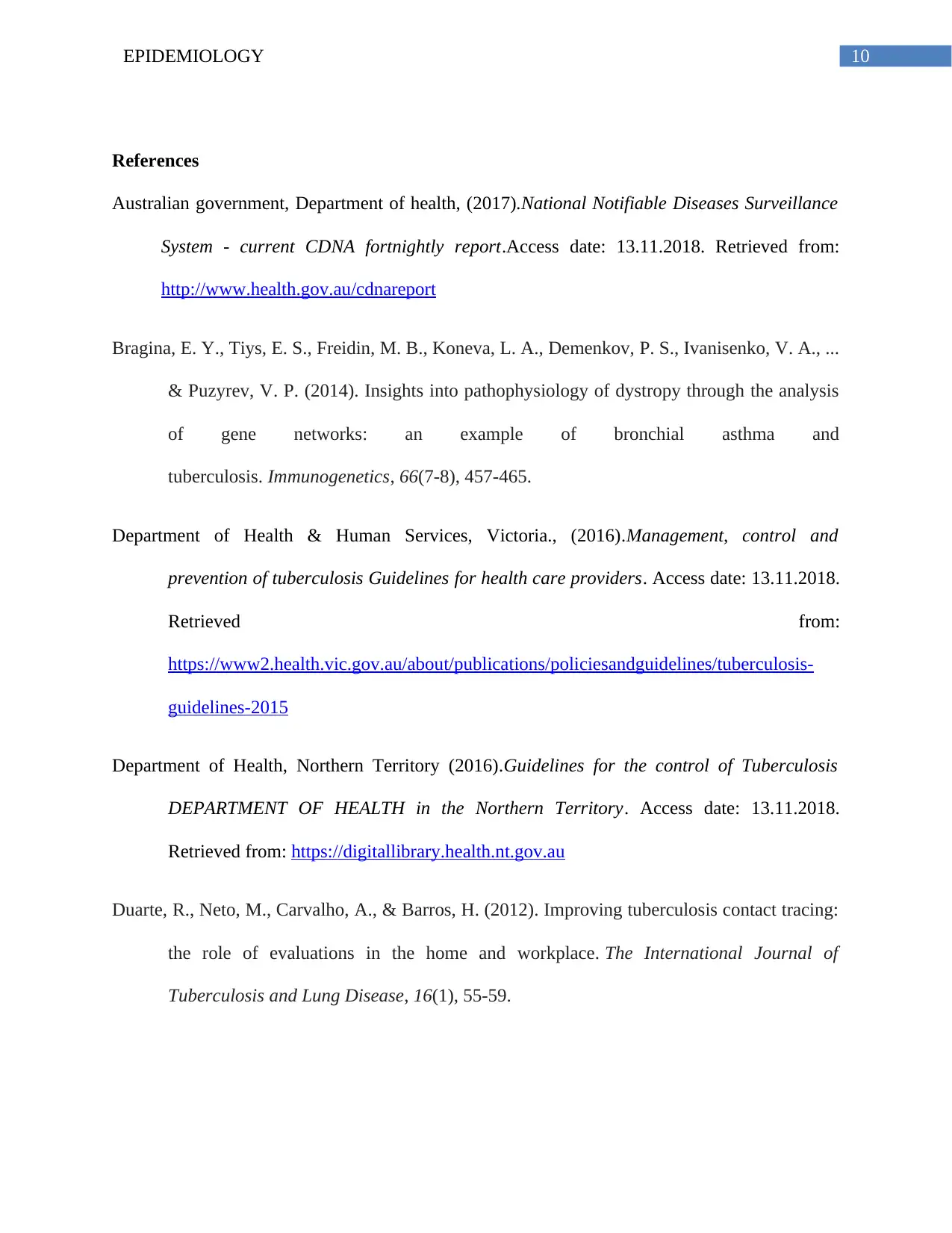
10EPIDEMIOLOGY
References
Australian government, Department of health, (2017).National Notifiable Diseases Surveillance
System - current CDNA fortnightly report.Access date: 13.11.2018. Retrieved from:
http://www.health.gov.au/cdnareport
Bragina, E. Y., Tiys, E. S., Freidin, M. B., Koneva, L. A., Demenkov, P. S., Ivanisenko, V. A., ...
& Puzyrev, V. P. (2014). Insights into pathophysiology of dystropy through the analysis
of gene networks: an example of bronchial asthma and
tuberculosis. Immunogenetics, 66(7-8), 457-465.
Department of Health & Human Services, Victoria., (2016).Management, control and
prevention of tuberculosis Guidelines for health care providers. Access date: 13.11.2018.
Retrieved from:
https://www2.health.vic.gov.au/about/publications/policiesandguidelines/tuberculosis-
guidelines-2015
Department of Health, Northern Territory (2016).Guidelines for the control of Tuberculosis
DEPARTMENT OF HEALTH in the Northern Territory. Access date: 13.11.2018.
Retrieved from: https://digitallibrary.health.nt.gov.au
Duarte, R., Neto, M., Carvalho, A., & Barros, H. (2012). Improving tuberculosis contact tracing:
the role of evaluations in the home and workplace. The International Journal of
Tuberculosis and Lung Disease, 16(1), 55-59.
References
Australian government, Department of health, (2017).National Notifiable Diseases Surveillance
System - current CDNA fortnightly report.Access date: 13.11.2018. Retrieved from:
http://www.health.gov.au/cdnareport
Bragina, E. Y., Tiys, E. S., Freidin, M. B., Koneva, L. A., Demenkov, P. S., Ivanisenko, V. A., ...
& Puzyrev, V. P. (2014). Insights into pathophysiology of dystropy through the analysis
of gene networks: an example of bronchial asthma and
tuberculosis. Immunogenetics, 66(7-8), 457-465.
Department of Health & Human Services, Victoria., (2016).Management, control and
prevention of tuberculosis Guidelines for health care providers. Access date: 13.11.2018.
Retrieved from:
https://www2.health.vic.gov.au/about/publications/policiesandguidelines/tuberculosis-
guidelines-2015
Department of Health, Northern Territory (2016).Guidelines for the control of Tuberculosis
DEPARTMENT OF HEALTH in the Northern Territory. Access date: 13.11.2018.
Retrieved from: https://digitallibrary.health.nt.gov.au
Duarte, R., Neto, M., Carvalho, A., & Barros, H. (2012). Improving tuberculosis contact tracing:
the role of evaluations in the home and workplace. The International Journal of
Tuberculosis and Lung Disease, 16(1), 55-59.

11EPIDEMIOLOGY
Falzon, D., Schünemann, H. J., Harausz, E., González-Angulo, L., Lienhardt, C., Jaramillo, E., &
Weyer, K. (2017). World Health Organization treatment guidelines for drug-resistant
tuberculosis, 2016 update. European Respiratory Journal, 49(3), 1602308.
Fox, G. J., Barry, S. E., Britton, W. J., & Marks, G. B. (2013). Contact investigation for
tuberculosis: a systematic review and meta-analysis. European Respiratory
Journal, 41(1), 140-156.
Hopewell, P. C. (2016). Treatment of tuberculosis. In Tuberculosis (pp. 128-158). CRC Press.
Horsburgh Jr, C. R., Barry III, C. E., & Lange, C. (2015). Treatment of tuberculosis. New
England Journal of Medicine, 373(22), 2149-2160.
Judge, D., & Krause, V. (2016). Multidrug-resistant tuberculosis in the Northern Territory: A 10-
year retrospective case series. Communicable diseases intelligence quarterly
report, 40(3), E334-E339.
Tian, Y., Osgood, N. D., Al-Azem, A., & Hoeppner, V. H. (2013). Evaluating the effectiveness
of contact tracing on tuberculosis outcomes in Saskatchewan using individual-based
modeling. Health Education & Behavior, 40(1_suppl), 98S-110S.
Wani, R. L. S. (2013). Tuberculosis 2: Pathophysiology and microbiology of pulmonary
tuberculosis. South Sudan Medical Journal, 6(1), 10-12.
World Health Organization. (2016). WHO treatment guidelines for drug-resistant tuberculosis
2016 update. World Health Organization.
World Health Organization. (2017). Guidelines for the treatment of drug-susceptible tuberculosis
and patient care.
Falzon, D., Schünemann, H. J., Harausz, E., González-Angulo, L., Lienhardt, C., Jaramillo, E., &
Weyer, K. (2017). World Health Organization treatment guidelines for drug-resistant
tuberculosis, 2016 update. European Respiratory Journal, 49(3), 1602308.
Fox, G. J., Barry, S. E., Britton, W. J., & Marks, G. B. (2013). Contact investigation for
tuberculosis: a systematic review and meta-analysis. European Respiratory
Journal, 41(1), 140-156.
Hopewell, P. C. (2016). Treatment of tuberculosis. In Tuberculosis (pp. 128-158). CRC Press.
Horsburgh Jr, C. R., Barry III, C. E., & Lange, C. (2015). Treatment of tuberculosis. New
England Journal of Medicine, 373(22), 2149-2160.
Judge, D., & Krause, V. (2016). Multidrug-resistant tuberculosis in the Northern Territory: A 10-
year retrospective case series. Communicable diseases intelligence quarterly
report, 40(3), E334-E339.
Tian, Y., Osgood, N. D., Al-Azem, A., & Hoeppner, V. H. (2013). Evaluating the effectiveness
of contact tracing on tuberculosis outcomes in Saskatchewan using individual-based
modeling. Health Education & Behavior, 40(1_suppl), 98S-110S.
Wani, R. L. S. (2013). Tuberculosis 2: Pathophysiology and microbiology of pulmonary
tuberculosis. South Sudan Medical Journal, 6(1), 10-12.
World Health Organization. (2016). WHO treatment guidelines for drug-resistant tuberculosis
2016 update. World Health Organization.
World Health Organization. (2017). Guidelines for the treatment of drug-susceptible tuberculosis
and patient care.

12EPIDEMIOLOGY
Zwerling, A., van den Hof, S., Scholten, J., Cobelens, F., Menzies, D., & Pai, M. (2012).
Interferon-gamma release assays for tuberculosis screening of healthcare workers: a
systematic review. Thorax, 67(1), 62-70.
Zwerling, A., van den Hof, S., Scholten, J., Cobelens, F., Menzies, D., & Pai, M. (2012).
Interferon-gamma release assays for tuberculosis screening of healthcare workers: a
systematic review. Thorax, 67(1), 62-70.
1 out of 13
Related Documents
Your All-in-One AI-Powered Toolkit for Academic Success.
+13062052269
info@desklib.com
Available 24*7 on WhatsApp / Email
![[object Object]](/_next/static/media/star-bottom.7253800d.svg)
Unlock your academic potential
© 2024 | Zucol Services PVT LTD | All rights reserved.





